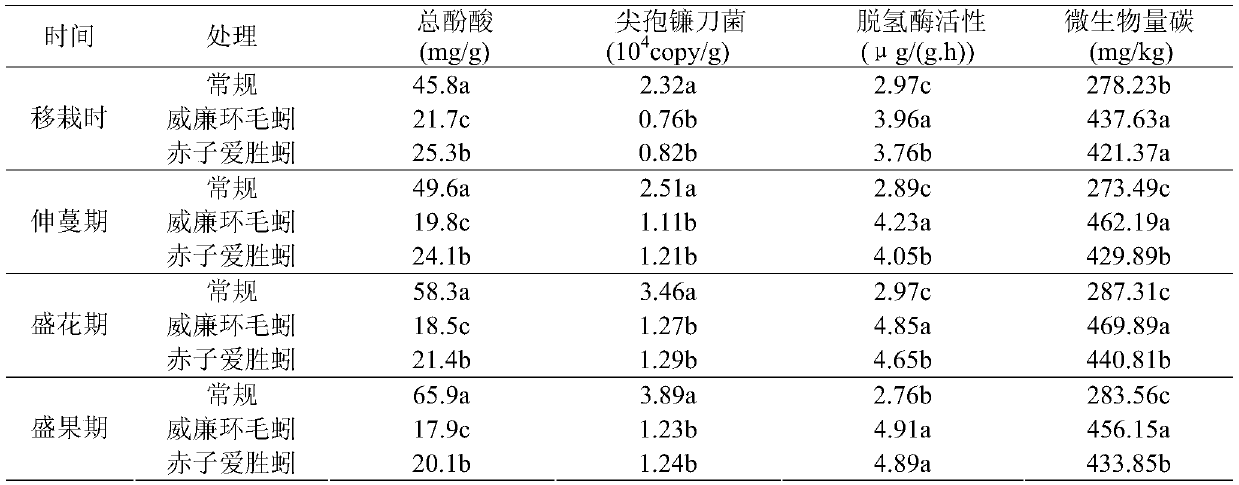Method for improving facility continuous-cropping soil by means of earthworms
A technology of earthworms and soil, applied in botany equipment and methods, soil preparation methods, applications, etc., can solve the problems of continuous cropping soil obstacles, low crop yield, and poor quality, so as to improve the quality of soil micro-ecological environment and promote crop growth Effects on development and growth promotion
- Summary
- Abstract
- Description
- Claims
- Application Information
AI Technical Summary
Problems solved by technology
Method used
Image
Examples
Embodiment 1
[0049] Set up facility sheds on the soil cultivated land, and set drainage ditches with a width of 20-30cm and a depth of 80-100cm around the facility shed. A water supply device is installed in the facility greenhouse, and the water supply device is selected from one or a combination of droppers or sprinkler irrigation equipment.
[0050] In the gap between crops in the facility greenhouse, earthworm feed is plowed into the soil plow layer. After plowing, ridges and furrows should be formed. The width of the ridges is 20-50 cm, and the distance between the ridges is 5-20 cm. The input amount of the selected earthworm feed includes 0.5-1.5 tons / mu of straw and 1.0-4.0 tons / mu of organic fertilizer. The straw needs to be crushed and then pre-composted for 7-15 days. The straw is selected from one or more of rice straw, vegetable waste, mushroom residue, green manure or grass. The organic fertilizer is selected from one or more mixtures of decomposed livestock and poultry manur...
Embodiment 2
[0054] In a 5-year watermelon continuous cropping greenhouse in a test base in Shanghai, watermelon continuous cropping obstacles are relatively serious (about 40% of watermelon wilts occurred in the previous crop) and the soil type is fluvo-aquic soil. Basic physical and chemical properties of barrier soil: Basic soil properties: pH7.72, electrical conductivity 1.18mS / cm, organic matter content 18.1g / kg, total nitrogen content 1.46g / kg, total phosphorus content 2.04g / kg, total potassium content 12.83g / kg kg.
[0055] Drainage ditches with a width of 24 to 26 cm and a depth of 85 to 95 cm are set around the facility greenhouse. A water supply device is installed in the facility greenhouse, and the water supply device is a dropper and sprinkler irrigation equipment. Different test areas in the facility greenhouse are separated by a 1m deep geomembrane to prevent mutual interference and influence.
[0056] After the watermelons are harvested in autumn in the watermelon continu...
Embodiment 3
[0060] In the above-mentioned Example 2, the soil in the facility greenhouse where the worms were put in and the earthworms were put in and the earthworms were not put in were tested, and the data on the physical and chemical properties of the soil are shown in Table 1.
[0061] It can be seen from Table 1 that the soil pH, electrical conductivity, and bulk density of the continuous cropping barrier soil in greenhouses in facilities that were fed with William's Ringworm and Chizi Eisensis (Taiping No. 2) were improved to varying degrees. Available potassium and organic matter are 30.6-36.7%, 31.3-45.6%, 18.8-19.3%, 34.7-37.2%, 53.3-64.4% higher than conventional treatment, respectively, and the ecological benefits are remarkable.
[0062] Table 1 Effects of feeding earthworms on soil physical and chemical properties
[0063]
[0064] Note: Different letters after the data in the same column indicate significant differences between treatments (P<0.05)
PUM
 Login to View More
Login to View More Abstract
Description
Claims
Application Information
 Login to View More
Login to View More - R&D
- Intellectual Property
- Life Sciences
- Materials
- Tech Scout
- Unparalleled Data Quality
- Higher Quality Content
- 60% Fewer Hallucinations
Browse by: Latest US Patents, China's latest patents, Technical Efficacy Thesaurus, Application Domain, Technology Topic, Popular Technical Reports.
© 2025 PatSnap. All rights reserved.Legal|Privacy policy|Modern Slavery Act Transparency Statement|Sitemap|About US| Contact US: help@patsnap.com



